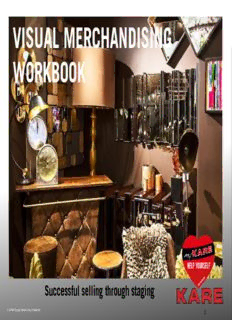
Visual Merchandising Booklet ENGLISH PDF
Preview Visual Merchandising Booklet ENGLISH
VISUAL MERCHANDISING WORKBOOK Successful selling through staging © KARE Design GmbH (Kay Petersen) 1 Foreword This presentation provides an overview of the KARE guidelines for decoration and the display of goods. These are the binding basis for the communication of the KARE lifestyle and they reflect the needs and behaviour of our customers as well as our philosophy. You will learn to see the shop and every detail through the eyes of the customer. The customer is like a guest who has been invited by us. All of us make sure our home looks its best when mother- in-law will be our guest – this is how the shop should look like! 2 Contents 1. Philosophy 6 2. What and why... VM 8 2.1. Targets 13 2.2. Customer psychology 15 2.3. AIDA principle 16 3. KARE- shop design 17 3.1. Customer walkways – The Loop 20 3.2. Lines of sight, focal points, orientation points 22 3.3. KARE – CD corporate design 26 3.4. Price displays 28 3 4. Shop elements 35 4.1 Shelving and rear walls 38 4.2 Presentation tables 42 4.3 Lounge shelf 45 4.4 Wall of accessories 46 4.5 Furniture wall 47 4.6 Illuminated pedestal 48 4.7 Lightning studio 50 4.8 Curtain display 51 4.9 Suspended goods 52 4.10 Wall of pictures 53 4.11 Mirror wall 54 5. Decoration 55 5.1 Contrasts / Style break 5.2 Viewing management 59 5.3 Provoking a feeling through a 62 clearly decoration atmosphere 4 6. Colour impact 64 7. Illumination effects 68 8. Booths – design 74 9. Shop window 82 10. General guidelines 85 11. Definitions 87 12. Help!!! 89 13. Inspirations 90 5 1. Philosophy 6 Shop concept According to the Pareto principle, 20% of the goods create 80% of the turnover. Nevertheless, the remaining 80% of goods are essential to tempt customers into our shops. Best-selling product are prominently presented and supported by skillful staging. We serve the daily bread as well as a fine portion of champagne. KARE sells more than product, it sells a feeling, a look and a life style - all together. An armchair is more than just a product - it is sexy, and as soon as you buy it, you are sexy as well. A customer becomes part of the KARE family, he experiences KARE. Our product claim is to adapt significant trends from the market quickly and turn them into affordable and available products. Kare is not decided on one kind of design trend but bets on unlimited variety. Our unique selling proposition is the staging of our trendshows. 7 2. What and why... Visual merchandising (= promoting sales through the eye) The visual elements consists of the impressions which are ● perceived through the eyes. Merchandising describes the goods and their sale. Visual merchandising is accordingly the visual display of the ● goods which are presented for sale. The storage is converted into a Boutique. 8 Visual Merchandising is oriented towards customer behaviour, the target group and the corporate design. It determines the look of the shop. It supports the customers in their decisions - enables them to buy on impulse and with more confidence. It promotes customer frequency and will increase turnover. 50% of all purchasing decisions are not taken until customers are in the sales area. 9 Rooms are set up, the so called „booths“. They harmonize with the KARE lifestyle and follow the given style guide (Shop design, corporate design, worlds of emotions, price labels etc.). In this way KARE differs from the competitors. The customer becomes aware of the brand. He gets faster into the shop, stays longer, can arrange himself better, buys more and has a higher memo value. The customer should be kept satisfied, until he will come again. The visual merchandising plays a supporting role. The independent sale is supported. The customer can arrange himself better. By showing the benefits, colour range and a homelike arrangement, you give the customer the chance to absorb the assortment faster and to understand it easier. 10
Description: